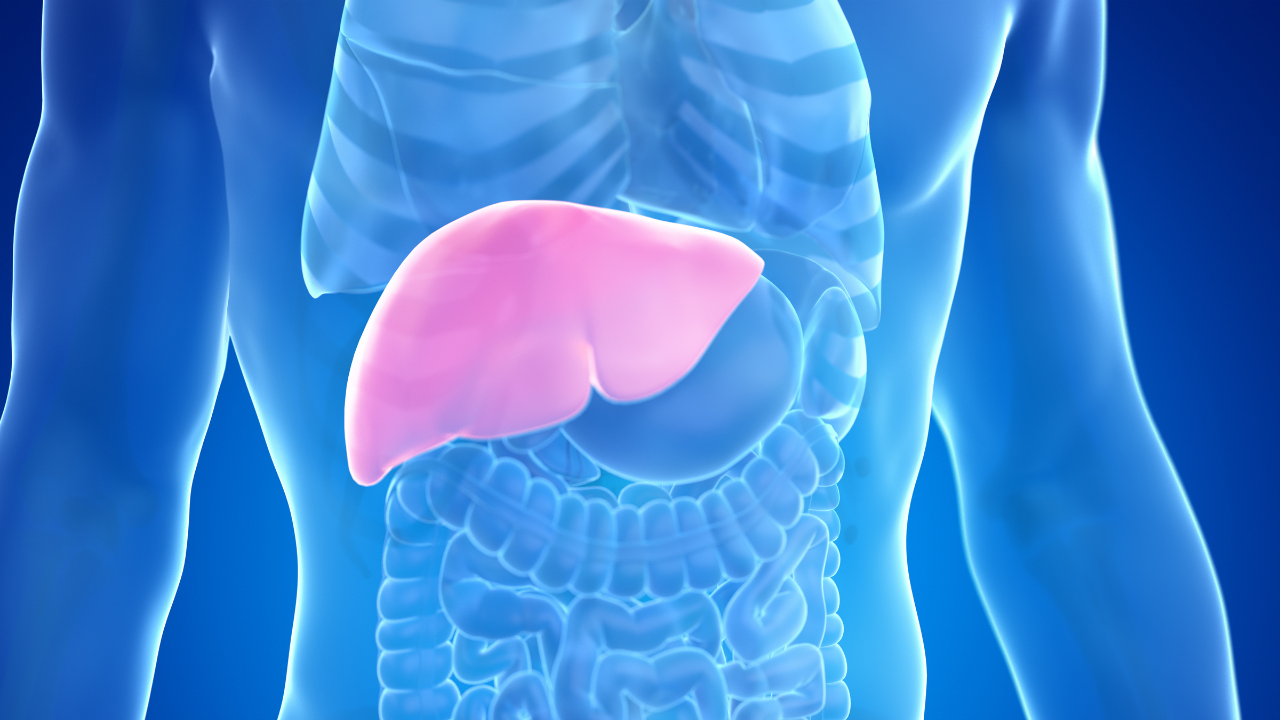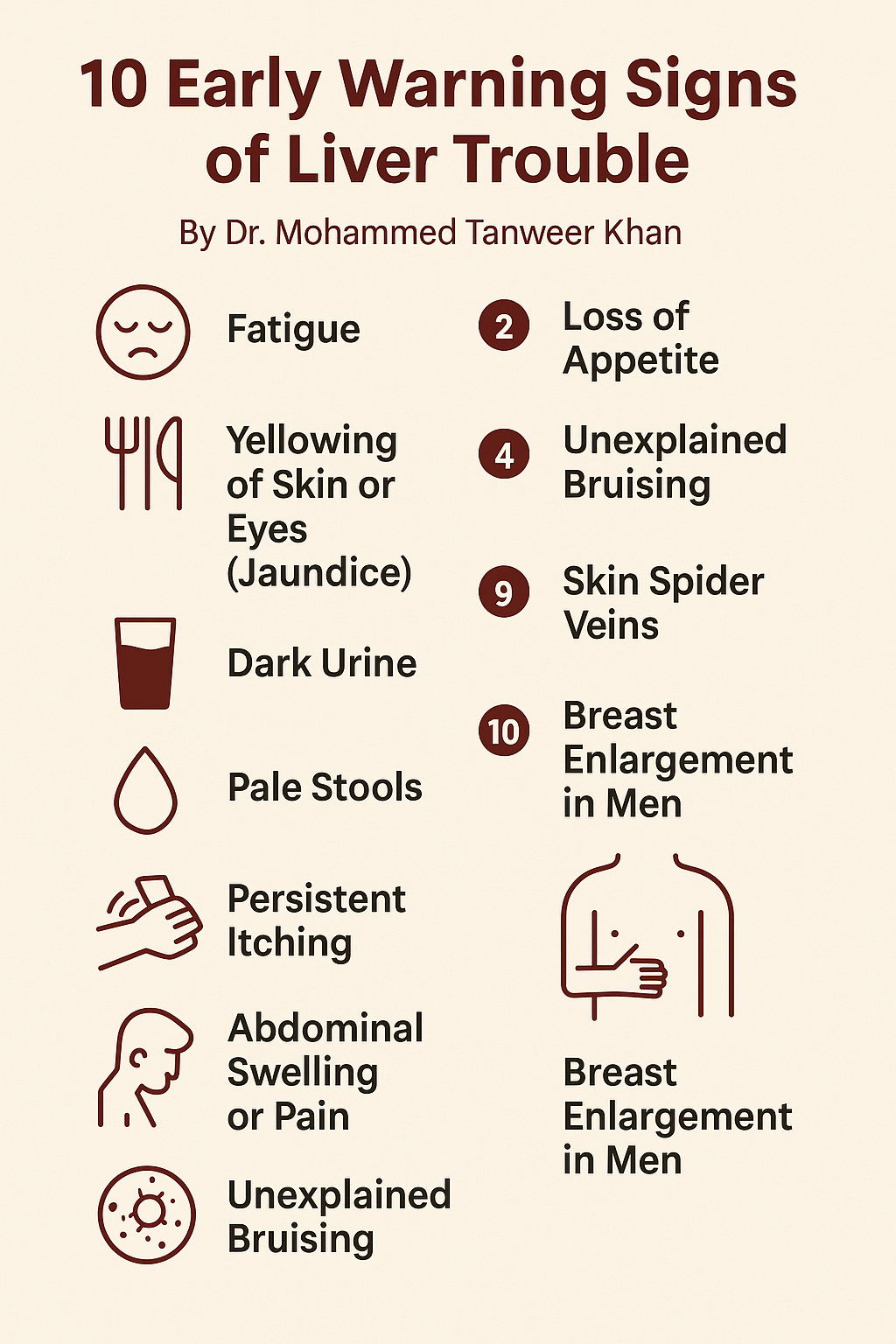Your Liver’s Hidden Language: Early Signs of Trouble

By Dr. MTK
Physician, Writer, Educator
In clinical practice, I have often described the liver as the body’s silent workhorse. It performs more than 500 essential functions — from processing nutrients and detoxifying harmful substances to producing proteins vital for blood clotting. Yet, despite its importance, the liver rarely “complains” until the damage is advanced. This makes recognizing the early signs of liver trouble critical for timely intervention.
The liver communicates distress in ways that may seem subtle or unrelated to many patients. Persistent fatigue and loss of appetite are common, often mistaken for general weakness or stress. In reality, these can be the first signs that the liver is struggling to manage its metabolic load.
One of the more visible warnings is yellowing of the skin or eyes (jaundice), caused by a build-up of bilirubin in the blood. Jaundice may appear gradually or suddenly, and it is never normal in adults — it requires urgent evaluation. Dark urine and pale stools can also indicate problems with bile flow, pointing to conditions such as hepatitis, gallstones, or bile duct obstruction.
The skin often carries the liver’s messages too. Persistent itching without a visible rash may result from bile salts accumulating in the skin. In some patients, small, spider-like blood vessels (spider angiomas) appear on the face, neck, or chest. Easy bruising and prolonged bleeding can occur when the liver’s protein production is impaired.
Unexplained abdominal swelling or bloating, especially when accompanied by discomfort in the right upper abdomen, can be a sign of fluid accumulation (ascites) — often linked to advanced liver disease. In men, enlargement of breast tissue (gynecomastia) or reduced body hair can result from hormonal imbalances caused by chronic liver injury.
It is important to remember that liver disease is not confined to those who consume alcohol. Viral hepatitis, fatty liver disease (often related to obesity or diabetes), autoimmune conditions, and certain medications can all quietly damage the liver over years.
The advantage we have as physicians is that liver problems can often be detected early through simple blood tests and imaging — long before irreversible damage sets in. Patients who act on early signs stand the best chance of halting or reversing the disease process.
Your liver’s language is subtle, but it is never silent. Listening to its early whispers — and seeking medical evaluation promptly — can protect one of the most vital organs in your body.

For Medical Students
The liver is a vital metabolic organ, performing over 500 known functions, including detoxification, nutrient processing, and synthesis of essential proteins. Despite this, it often remains clinically silent until significant damage has occurred. This makes early recognition of hepatic dysfunction an important skill for future physicians.
Key Early Signs and Their Pathophysiology:
• Fatigue and Loss of Appetite: May result from impaired metabolism and toxin build-up.
• Jaundice: Yellowing of the skin and sclera occurs when serum bilirubin rises due to impaired conjugation or excretion.
• Dark Urine and Pale Stools: Reflect altered bile pigment metabolism or obstructed bile flow.
• Pruritus: Often due to deposition of bile salts in the skin.
• Easy Bruising: Indicates reduced synthesis of clotting factors by hepatocytes.
• Spider Angiomas: Capillary dilations related to hyperestrogenemia in chronic liver disease.
• Ascites: Accumulation of fluid in the peritoneal cavity due to portal hypertension and hypoalbuminemia.
Learning Point: Always approach skin, GI, and systemic signs with a differential that includes hepatic pathology. Laboratory evaluation with liver function tests (LFTs) can confirm suspicion before irreversible damage occurs.
2. For Young Doctors
In early practice, you will encounter patients presenting with vague symptoms that mask underlying liver disease. The key is to identify subtle patterns and act before progression.
Common Early Clinical Presentations:
• Non-specific symptoms such as tiredness, anorexia, or right upper quadrant discomfort — don’t dismiss them as minor without considering hepatic causes.
• Physical clues like jaundice, spider angiomas, palmar erythema, or unexplained pruritus should prompt liver function testing.
• Urine and stool changes (dark urine, clay-colored stools) suggest cholestasis or biliary obstruction.
• Unexplained bruising or bleeding may be your first clue to reduced hepatic synthetic capacity.
• Hormonal changes (gynecomastia in men, amenorrhea in women) can reflect chronic disease effects.
Clinical Tip:
Order baseline LFTs, coagulation profile, viral hepatitis screening, and abdominal ultrasound early. Early intervention in hepatitis B/C, NAFLD, or autoimmune hepatitis can significantly alter prognosis.
3. For General Practitioners
In general practice, the liver is often “silent” until late disease, so your role in early detection is crucial. Many patients will present with vague or non-specific symptoms; recognizing patterns is vital.
Red-Flag Signs to Investigate Promptly:
• Persistent fatigue or anorexia without obvious cause.
• Jaundice in any adult — treat as urgent for evaluation.
• Dark urine / pale stools — think bile flow obstruction or hepatitis.
• Persistent itching without rash — consider cholestasis.
• Abdominal distension — exclude ascites early.
• Easy bruising / prolonged bleeding — suspect reduced clotting factor production.
Primary Care Actions:
• Detailed history — alcohol use, hepatitis risk factors, metabolic syndrome.
• Focused examination — stigmata of chronic liver disease, hepatomegaly, splenomegaly.
• First-line investigations — LFTs, hepatitis serology, coagulation profile, abdominal ultrasound.
• Refer early if red flags or progressive abnormality are found.
Clinical Reminder: Non-alcoholic fatty liver disease is increasingly common in patients with diabetes, obesity, and dyslipidemia — screen actively.